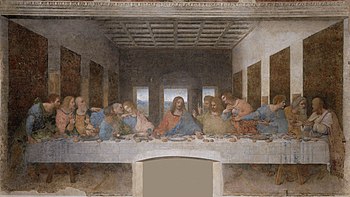
Back Abendmahl Jesu ALS العشاء الأخير Arabic ܚܫܡܝܬܐ ܐܚܪܝܬܐ ARC العشاء الاخير ARZ Sonuncu şam yeməyi Azerbaijani Huring Pamanggi BCL Тайная вячэра Byelorussian Тайната вечеря Bulgarian নিস্তারপর্বের ভোজ Bengali/Bangla Koan Diwezhañ Breton

The Last Supper is the final meal that, in the Gospel accounts, Jesus shared with his apostles in Jerusalem before his crucifixion.[1]
The Apostle Paul tells of this supper in his first letter to the Corinthians. The Synoptic Gospels all tell of Jesus using the bread and wine as symbols of his body and blood. the Gospel of John does not include those details but tells of Jesus washing the feet of the disciples. This has led to some Christian groups having a ritual of foot washing as a sign of humility.
The Last Supper is commemorated by Christians especially on Maundy Thursday.[2] The Last Supper provides the purpose for Eucharist, also known as "Holy Communion" or "The Lord's Supper".[3]
- ↑ "Last Supper. The final meal Christ with His Apostles on the night before the Crucifixion.", Cross, F. L., & Livingstone, E. A. (2005). The Oxford Dictionary of the Christian Church (3rd ed. rev.) (958). Oxford; New York: Oxford University Press.
- ↑ Gwyneth Windsor, John Hughes (21 November 1990). Worship and Festivals. Heinemann. ISBN 978-0435302733. Retrieved 11 April 2009.
On the Thursday, which is known as Maundy Thursday, Christians remember the Last Supper which Jesus had with His disciples. It was the Jewish Feast of the Passover, and the meal which they had together was the traditional Seder feast, eaten that evening by the Jews everywhere.
- ↑ Walter Hazen (1 September 2002). Inside Christianity. Lorenz Educational Press. ISBN 978-0787705596. Retrieved 3 April 2012.
The Anglican Church in England uses the term Holy Communion. In the Roman Catholic Church, both terms are used. Most Protestant churches refer to it simply as communion or The Lord's Supper. Communion reenacts the Last Supper that Jesus ate with His disciples before he was arrested and crucified.